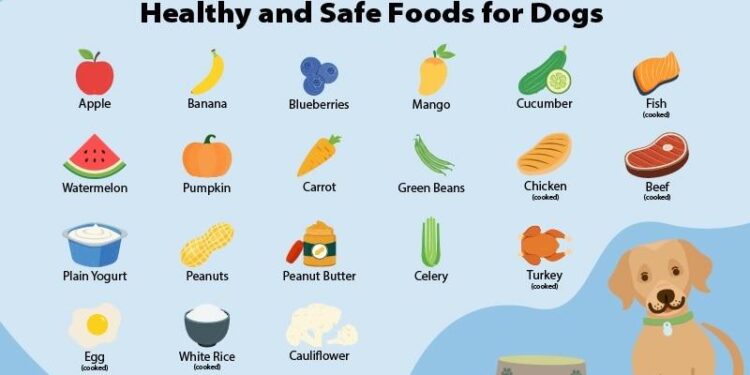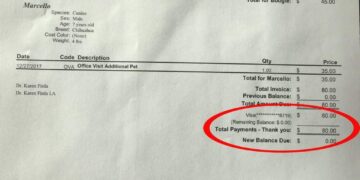Table of Contents
Subtitle: How a desperate search for answers led me past marketing myths and prescription dead-ends to the one solution that healed my dog from the inside out.
Introduction: The Unbearable Sound of Suffering
There are sounds that define a home: the gentle hum of the refrigerator, the distant murmur of traffic, the soft creak of floorboards settling in the night.
For years, the defining sound of my home was the sound of my dog, Leo, suffering.
It was a symphony of misery played on a loop: the frantic, rhythmic thump-thump-thump of his leg against the hardwood floor as he scratched an itch that could never be satisfied; the wet, incessant slurp of him licking his raw, inflamed paws; the soft whimpers in his sleep.
That sound was the soundtrack to my helplessness.
Leo, a bright-eyed, endlessly optimistic golden retriever, was my shadow, my confidant, my furry, four-legged soulmate.
And he was profoundly unwell.
Our life together had become a blur of vet visits, cone collars, and a medicine cabinet overflowing with creams, sprays, and pills that offered only fleeting moments of relief.
His beautiful golden coat was thin and patchy.
His skin, especially on his belly and between his paws, was a constant, angry R.D.1
We battled recurrent ear infections that left him shaking his head in discomfort and a persistent, low-grade digestive turmoil that announced itself with gurgling sounds from his stomach, noxious gas, and unpredictable bouts of diarrhea.1
The emotional toll was immense.
Every night, the sound of his scratching was a fresh stab of guilt.
I was his guardian, his entire world, and I was failing him.
I followed every piece of professional advice, bought every recommended product, and yet, the suffering continued.
My frustration curdled into a quiet despair, a feeling many pet owners know all too well, a silent scream into the void of online forums where countless others share similar stories of chronic, unresolved ailments.6
In a strange way, we had normalized it.
The vet would sigh sympathetically and say things like, “Well, retrievers are prone to allergies,” or “It’s just a sensitivity he’ll have to live with.” We were told to manage the symptoms, not to expect a cure.
This is a quiet tragedy playing out in homes across the country: the acceptance of chronic, low-grade illness as an unavoidable part of a pet’s life.
We are conditioned to see our companions not as the vibrant, resilient creatures they should be, but as beings predisposed to a lifetime of management and medication.1
But one sleepless night, listening to Leo’s distressed scratching from the foot of my bed, I decided I could no longer accept this “new normal.” His discomfort was a constant alarm bell, and I realized the conventional path—the one paved with good intentions and expensive failures—was a dead end.
I had to find a different Way. I had to answer the call his suffering was sending O.T.
Part I: The Labyrinth of “Good Intentions”
My journey began, as it does for so many devoted pet owners, in the brightly lit, overwhelmingly colorful aisles of a high-end pet boutique.
It was a labyrinth of promises, each bag and can a siren call of health and vitality.
I was determined to buy my way out of Leo’s misery, armed with a credit card and a desperate hope that the solution was simply a matter of price point.
I was wrong.
This initial phase of my quest was a masterclass in the seductive, and ultimately hollow, world of modern pet food marketing.
The Seduction of the “Premium” Shelf
I stood before a wall of kibble, a mosaic of beautiful packaging depicting majestic wolves, verdant fields, and glistening cuts of meat.
The words leaped out at me: “Premium,” “Natural,” “Holistic,” “Gourmet.” I chose the most expensive bags, the ones with ingredient lists that read like a recipe from a farm-to-table restaurant: “deboned chicken,” “garden peas,” “sweet potatoes,” “wild blueberries.” I felt a surge of confidence.
This was it.
This was what a good owner did.
The reality, as I would later learn, is that these terms are often marketing gimmicks with little to no legal or nutritional significance.
“Premium” and “holistic” are entirely undefined and unregulated, designed to appeal to my human emotions, not my dog’s biological needs.10
Even “natural,” which does have a broad legal definition by the Association of American Feed Control Officials (AAFCO), can include almost any plant, animal, or mined ingredient, rendering the term virtually meaningless as a guarantee of quality.12
I had fallen headfirst into the “ingredients first” fallacy, a clever marketing strategy that has become dogma in the premium pet food space.13
Brands build entire campaigns around the idea that if the first ingredient is a whole meat, the food is superior.
It feels logical, empowering the consumer to “do their own research” by simply reading a label.
I felt smart, discerning.
But I didn’t understand that the quality of a diet isn’t determined by a list of ingredients, but by the total nutritional profile, the bioavailability of those nutrients after processing, and the absence of harmful components.
The “fresh chicken” that sounded so appealing was mostly water, a marketing trick to get it to the top of the ingredient list, while a more nutrient-dense ingredient like “chicken meal” would appear further down.14
I was also drawn to the brands that plastered images of wolves on their bags, believing this was a shorthand for a biologically appropriate, ancestral diet.15
It was a powerful, primal appeal.
Yet, despite the beautiful bags and the four-figure credit card bills, Leo’s condition didn’t improve.
The scratching continued, the digestive upset lingered.
I felt duped, a common sentiment among owners who discover that the premium price they paid bought a compelling story, not a superior product.17
The Prescription Paradox: A Scientific Dead End
Defeated, I returned to my veterinarian.
After another examination and a review of our failed dietary experiments, he nodded gravely and wrote a prescription.
This, he explained, was the “gold standard” for diagnosing and managing food allergies: a hydrolyzed protein diet.2
The science sounded impressive and definitive.
In a food allergy, the dog’s immune system mistakenly identifies a normal dietary protein (like chicken or beef) as a threat and launches an inflammatory attack.
Hydrolysis, he explained, uses water and enzymes to break these proteins down into tiny fragments—peptides and amino acids—so small that they become immunologically “invisible.” The immune system’s sentinels can no longer recognize them as the enemy, and the allergic reaction ceases.21
It was presented as the ultimate scientific solution, a way to bypass the problem entirely.
I left the clinic with a case of cans that cost more than my own groceries, filled with a renewed, albeit fragile, sense of hope.
That hope disintegrated within 48 hours.
First, Leo refused to eat it.
He would sniff the grey, pasty substance in his bowl and look up at me with an expression of utter betrayal.
I learned that the very process of hydrolysis, which makes the food “safe,” also makes it intensely bitter and unpalatable to many dogs.22
I tried coaxing him, mixing it with a little warm water, sitting with him and encouraging him.
When he finally, reluctantly, ate a small amount, the second failure became apparent: his symptoms didn’t go away.
The itching was perhaps marginally better, but the diarrhea returned with a vengeance.
This was my narrative low point.
I had trusted the marketplace, and it had sold me a myth.
I had trusted the pinnacle of veterinary science, and it had given me an expensive, unpalatable failure.
What I didn’t know then, but discovered in the furious, late-night research that followed, was that my experience was tragically common.
These “gold standard” diets have a clinical failure rate as high as 50%.24
The reasons are a shocking indictment of the system.
Often, the protein hydrolysis is incomplete, leaving fragments large enough to still trigger an immune response.23
Even more damning, studies have found that the vast majority of these prescription diets are contaminated with other proteins during manufacturing, completely negating their purpose as a diagnostic tool.24
The very diet meant to eliminate variables was, in fact, a nutritional black box.
It was at this moment that I began to understand the deeper flaw in my approach.
Both the “premium” kibbles and the “scientific” prescription diets were, at their core, highly processed products.26
They were designed with a strategy of avoidance—avoiding “bad” ingredients or avoiding an immune trigger.
But neither was designed to actively
heal the underlying dysfunction that was causing the problems in the first place.
A hydrolyzed diet might remove the specific protein Leo was reacting to, but it did nothing to address the damaged, over-reactive immune system and compromised gut that allowed the allergy to develop.
It was like trying to stop a flood by plugging one leak in a dam that was crumbling from its foundations.
The problem wasn’t just the ingredients; it was the entire ecosystem within my dog.
I had been trying to treat the smoke, while completely ignoring the fire raging inside.
Part II: The Ancestral Echo
My disillusionment became my motivation.
The failure of the established systems forced me to look beyond them.
If the answers weren’t on the pet store shelves or in the vet’s office, I had to find them myself.
I turned from a passive consumer into a relentless researcher.
My quest was no longer for a product, but for an understanding.
I started asking a more fundamental question: not “What brand should I feed my dog?” but “What is a dog, and what is he truly built to eat?” This shift in perspective led me to a series of revelations that would change everything.
Beyond the Bowl: Re-examining the Dog
I dove into the evolutionary history of canines.
For thousands of years, the ancestors of our modern dogs thrived not on extruded, starchy pellets, but on a diet dictated by nature: they were hunters and scavengers.
Their physiology was, and largely remains, optimized for a diet high in quality animal protein, rich in balanced fats, and containing only minimal carbohydrates from the stomach contents of prey or foraged vegetation.28
This wasn’t about romanticizing the wolf or suggesting I should release Leo into the wild.
It was about respecting his biological inheritance.
While domestication has given dogs some increased ability to digest starches, their fundamental digestive tract—short, acidic, and designed for the rapid processing of meat and fat—remains remarkably similar to that of their wild cousins.31
This new knowledge cast the kibble I had been feeding him in a horrifying new light.
I learned about extrusion, the violent, high-heat, high-pressure process used to manufacture nearly all dry pet food.
This process doesn’t just cook the ingredients; it fundamentally alters them.
It can destroy fragile vitamins and enzymes, denature proteins, and, most alarmingly, create harmful chemical compounds like Advanced Glycation End-Products (AGEs).
These AGEs are known to promote systemic inflammation and are linked to accelerated aging and chronic disease.27
The “healthy,” “complete and balanced” food I had been dutifully scooping into his bowl was, in reality, a highly processed, biologically inappropriate substance that was likely contributing to the very inflammation I was trying to solve.
The Garden Within: Unlocking the Microbiome
The final, crucial piece of the puzzle fell into place when I stumbled upon the science of the gut microbiome.
This was the “epiphany,” the moment all of Leo’s disparate symptoms coalesced into a single, understandable whole.
The concept can be daunting, a world of trillions of invisible organisms.
To grasp it, I developed an analogy that became my guiding principle: the gut is not just a digestive tube; it is a living, breathing ecosystem—a wild, intricate garden thriving inside my dog.36
In this analogy, a healthy gut is like a flourishing, diverse native garden.
It’s teeming with thousands of different species of beneficial bacteria, yeasts, and other microbes (the “native plants”).
These organisms live in a complex, symbiotic state, working together to break down food into usable nutrients, manufacture essential vitamins, regulate the immune system, and even influence mood and behavior.
They maintain the health of the “soil” (the gut lining), keeping it strong and intact.
A healthy, diverse garden creates a healthy, resilient host.36
Highly processed kibble, with its high starch content, denatured proteins, and chemical additives, is like dumping a load of chemical fertilizer and broad-spectrum pesticides onto this delicate garden every single day.39
It kills off the diverse, beneficial native species and provides the perfect fuel for a few hardy, opportunistic “weeds” (like certain strains of
Clostridium or E.
coli) to grow out of control.
This state of imbalance is known as dysbiosis.39
As I read about dysbiosis, it was as if a light switch flipped on in a dark room.
The overgrown “weeds” in Leo’s gut were producing inflammatory compounds.
The lack of beneficial species meant the “soil” of his gut lining was becoming weak and permeable—a condition known as “leaky gut.” This allowed undigested food particles and inflammatory bacterial byproducts to leak into his bloodstream, putting his immune system on constant, red-alert status.41
Suddenly, everything made sense.
His chronic itching and red skin weren’t just a skin problem.
His recurrent ear infections weren’t just an ear problem.
His diarrhea and gas weren’t just a digestive problem.
They were all external manifestations of a single, internal catastrophe: a ruined gut garden.
The microbiome was the Rosetta Stone that translated all of his seemingly unrelated symptoms into one coherent language of systemic inflammation, originating from a profound imbalance in his gut.37
My quest was redefined.
I was no longer looking for a hypoallergenic food or a limited-ingredient diet.
I was no longer trying to simply avoid a trigger.
My mission was now proactive and clear: I had to find a food that could do more than just feed Leo.
I had to find a food that could weed, seed, and tend his inner garden, restoring the natural, ancestral balance that had been lost.
Part III: The Hunt for a True Solution
Armed with this powerful new framework—the intersection of ancestral nutrition and microbiome science—I began my search anew.
This time, I was not a passive consumer swayed by pretty pictures of wolves or promises of “garden vegetables.” I was an investigator with a clear set of non-negotiable criteria.
I sifted through brands, dismissing the ones that relied on emotional founder stories or marketing hype.18
I was looking for a company with a different philosophy, one grounded in biological principles and transparent practices.
A Different Philosophy: Transparency Over Hype
It was in the fine print of an online seller’s page that I first encountered ‘Hunger of the Wolf’.
What immediately set it apart was not what it promised, but what it explained.
The brand was unabashedly honest about its core ingredient: meat meal.
My previous self, conditioned by years of “fresh is best” marketing, would have dismissed this instantly.
But my new, educated self knew better.
I had learned that “fresh lamb,” for instance, is composed of 70-90% water.
While it sounds appealing, its contribution to the final, dry kibble’s protein content is minimal once the water is cooked O.T. “Lamb meal,” on the other hand, is simply fresh lamb that has already had the moisture removed before being ground into a powder.
It is a far more concentrated, stable, and potent source of animal protein.14
‘Hunger of the Wolf’ didn’t hide this fact; they highlighted it on their “real label.” They stated, “In The Hunger of The Wolf dog food we use meal so we do not claim very high content of raw meat only to make the labels look much better to the consumer than they really are”.14
This was a revelation.
Here was a company that chose to educate its customers rather than manipulate them.
This single act of transparency built a foundation of trust that no slick marketing campaign ever could.
They weren’t just selling a product; they were respecting my intelligence and validating the research I had done.
The Perfect Formula for Leo (Lamb & Rice)
With this newfound trust, I examined their formulas.
The Lamb & Rice recipe for adult dogs with sensitive digestion seemed tailor-made for Leo’s needs.
It aligned perfectly with my new, science-backed checklist.
First, it was built around a novel protein.
After years of eating chicken- and beef-based foods, Leo had almost certainly developed sensitivities to these common proteins.
Lamb provided a high-quality protein source that his immune system had likely never encountered, dramatically reducing the chance of an allergic reaction.2
Second, it was hypoallergenic by design.
The formula was explicitly free from poultry meat and wheat gluten, two of the most notorious culprits behind food allergies and intolerances in dogs.14
Instead of just removing one potential allergen, it was formulated to avoid a whole class of common triggers.
Third, the ingredient list reflected a commitment to quality and function.
Beyond the concentrated lamb meal, it included a blend of natural antioxidants from plant extracts like rosemary, turmeric, and citrus to help combat the systemic inflammation that had been plaguing Leo’s body.14
It was a formula built not just for sustenance, but for therapeutic support.
Tending the Inner Garden: The FMP System
The final, decisive factor was my discovery of the brand’s proprietary “FMP system.” This was the answer to my ultimate question: how would this food actively restore Leo’s devastated “gut garden”? The FMP system wasn’t just a marketing acronym; it was a targeted, synergistic strategy for microbiome restoration, composed of the very ingredients my research had identified as critical for gut health.14
I broke down the components:
- F is for Fructooligosaccharides (FOS): A powerful prebiotic fiber. Prebiotics are the specialized food that selectively nourishes the beneficial bacteria in the gut. FOS acts as the “high-quality compost and fertilizer” for the garden, encouraging the “native plants” to grow strong and crowd out the “weeds”.14
- M is for Mannan-oligosaccharides (MOS): Another crucial prebiotic, derived from the cell walls of yeast. MOS not only feeds beneficial bacteria but also has the unique ability to act as a decoy, binding to harmful pathogens and preventing them from attaching to the intestinal wall. They are the “beneficial companion plants” that actively protect the garden from invaders.14
- P is for Probiotics: The formula is fortified with probiotics—the live, beneficial bacteria themselves. These are the “new seeds” scattered onto the prepared soil, helping to repopulate the garden with diverse, healthy species and restore the balance lost to dysbiosis.14
This was a complete, three-pronged approach.
The system was further supported by ingredients like Yucca, known to improve digestion and reduce stool odor, and beta-glucans, which provide an additional boost to the immune system.14
It was a holistic system designed to do exactly what I needed: to stop fighting the symptoms and start healing the core problem from the inside O.T. The choice was clear and unequivocal.
| Feature | The Prescription Diet Failure (Hydrolyzed) | The Hunger of the Wolf Solution (Lamb & Rice) |
| Core Philosophy | Clinical Intervention: Avoid the allergic trigger, effectively masking the symptom.20 | Ancestral Nutrition: Address the root cause by restoring the gut ecosystem.39 |
| Primary Protein | Hydrolyzed chicken/soy. Processed to be “invisible” to the immune system, but often unpalatable and nutritionally compromised.22 | Concentrated, high-quality lamb meal. A novel, nutrient-dense protein source that is highly digestible.14 |
| Key Allergens | Theoretically free of allergens, but high risk of cross-contamination and incomplete hydrolysis leading to reactions.24 | Purposefully formulated to be free of the most common triggers like poultry and wheat gluten.14 |
| Gut Health Support | None. Does not address the underlying gut dysbiosis that causes the immune overreaction.24 | The FMP System: A targeted blend of prebiotics (FOS, MOS) and probiotics to actively rebuild and nourish the gut microbiome.14 |
| Transparency | Opaque, clinical branding. Relies on veterinary authority. The term “prescription” itself is a marketing tool.54 | “Real Label” Philosophy: Honest about using meat meal and its benefits, building consumer trust through education.14 |
Conclusion: The Wolf at Peace
The first bag of ‘Hunger of the Wolf’ arrived.
I measured out the first meal with a sense of cautious optimism that felt foreign after so many disappointments.
Leo, who had become wary of his food bowl, approached, sniffed, and then, to my profound relief, began to eat with gusto.
The changes didn’t happen overnight, but they were steady and undeniable.
The first thing I noticed was in his digestion.
Within a week, the gurgling in his stomach subsided, and his stools became consistently firm and healthy—a small but significant victory.55
Then, gradually, the frantic scratching began to lessen.
The angry redness of his skin started to fade, first from his belly, then from his paws.
The maddening
thump-thump-thump that had been the soundtrack to our lives grew quieter, and then, one day, it was gone.
It was replaced by the sound of silence.
A peaceful, comfortable silence.
The sound of a dog at ease in his own skin.
Today, Leo is a different dog.
He is the dog he was always meant to be.
His golden coat has grown back thick, soft, and gleaming.
His energy is boundless; our walks are longer, our games of fetch more spirited.
He sleeps through the night, not in a fitful, itchy daze, but in the deep, contented slumber of a healthy animal.
He is a living testament to the power of biologically appropriate nutrition, a walking success story echoing the testimonials of so many others who have made the switch to a diet that honors their pet’s true nature.55
My journey with Leo taught me a crucial lesson.
Caring for our canine companions requires more than just love and good intentions.
It demands that we look past the persuasive marketing, question the conventional wisdom, and strive to understand the profound biological needs of the animals we have invited into our homes.
It requires us to see not just the domesticated pet, but the ancestral wolf that still resides within.
True health doesn’t come from a lab or a marketing meeting; it comes from nourishing that ancient, fundamental blueprint.
The brand’s tagline is more than a slogan; it’s a mission statement.
It’s a call to satisfy not just the simple pang of an empty stomach, but the deeper, instinctual craving for the nutrition that builds vitality from the core.
It’s a call to heal the garden within.
It’s a call to Feed The Hunger.
Works cited
- Top 10 Health Issues in Dogs Every Pet Owner Should Know …, accessed August 13, 2025, https://www.bpah.net/blog/top-10-health-issues-in-dogs-every-pet-owner-should-know
- Best Food for Dogs With Allergies | Thornton Vet – Caring Hands Veterinary Hospital, accessed August 13, 2025, https://www.denvervet.com/site/blog/2021/12/30/best-food-for-dogs-with-allergies
- Understanding Pet Allergens: Choosing the Right Food For Pet Skin Allergy and Managing Dietary Triggers – Creedmoor Road Animal Hospital, accessed August 13, 2025, https://creedmoorroadanimalhospital.com/pet-dermatology-in-raleigh-nc/understanding-pet-allergens-choosing-the-right-food-for-pets-and-managing-dietary-triggers/
- Food Intolerance in Dogs: Symptoms, Signs, & Treatment [2024] – KOHA Pet, accessed August 13, 2025, https://kohapet.com/blogs/news/tips-for-treating-food-intolerance-in-dogs
- Stomach Sensitivities in Dogs – Greencross Vets, accessed August 13, 2025, https://www.greencrossvets.com.au/dog-stomach-sensitivities/
- Hello all, looking for a reputable replacement dog food brand. Love the current food but it’s just getting to be more than my car payments lol did a quick google search and don’t like recommendations from the one getting paid to sell the product : ) TIA!! : r/OpenDogTraining – Reddit, accessed August 13, 2025, https://www.reddit.com/r/OpenDogTraining/comments/10md24f/hello_all_looking_for_a_reputable_replacement_dog/
- Bad Experience with The Farmer’s Dog food : r/dogs – Reddit, accessed August 13, 2025, https://www.reddit.com/r/dogs/comments/15ac27w/bad_experience_with_the_farmers_dog_food/
- TASTE OF THE WILD complaints | Dog Food Advisor, accessed August 13, 2025, https://www.dogfoodadvisor.com/forums/topic/taste-of-the-wild-complaints/
- Lifetime prevalence of owner-reported medical conditions in the 25 most common dog breeds in the Dog Aging Project pack – Frontiers, accessed August 13, 2025, https://www.frontiersin.org/journals/veterinary-science/articles/10.3389/fvets.2023.1140417/full
- Pet Food Marketing Is Confusing And Misleading – Gardner Animal Care Center, accessed August 13, 2025, https://gardneranimalcarecenter.com/pet-food-marketing-is-confusing-and-misleading/
- Dog food, the politics of production and marketing gimmicks – NYC Doggies, accessed August 13, 2025, https://nycdoggies.com/wellness/dog-food-politics/
- Busted! Debunking the top five pet food myths – VCA Animal Hospitals, accessed August 13, 2025, https://vcahospitals.com/shop/articles/debunking-the-top-five-pet-food-myths
- Deconstructing old mindsets : r/DogFood – Reddit, accessed August 13, 2025, https://www.reddit.com/r/DogFood/comments/1fq3gnz/deconstructing_old_mindsets/
- The Hunger of the Wolf – Dry Food For Adult Dogs with Lamb & Rice – 14 kg | eBay UK, accessed August 13, 2025, https://www.ebay.co.uk/itm/285339013245
- The Hunger of the Wolf Light Formula Sterilised/ Overweight Dogs – Pet Food Expert, accessed August 13, 2025, https://petfoodexpert.com/food/the-hunger-of-the-wolf-light-formula-sterilised-overweight-dogs
- Kibble review? Wolf of Wilderness, made in Germany : r/dogs – Reddit, accessed August 13, 2025, https://www.reddit.com/r/dogs/comments/s4ysuh/kibble_review_wolf_of_wilderness_made_in_germany/
- Pet Food Review: Assessing the Best Dog and Cat Food for Your Pets | TikTok, accessed August 13, 2025, https://www.tiktok.com/@houseofpawsboutique/video/7392048861746892037
- “My Dog Was Sick, So I Made a Pet Food Brand” – The Industry’s Most Misleading Marketing Gimmick – NorthPoint Pets & Company, accessed August 13, 2025, https://www.northpointpets.com/blog-pet-food-marketing-gimmicks/
- Food Allergy: Diagnostics & Therapeutic Food Options | Today’s Veterinary Practice, accessed August 13, 2025, https://todaysveterinarypractice.com/nutrition/food-allergy-diagnostics-therapeutic-food-options/
- Hydrolyzed Diets – NC State Veterinary Hospital, accessed August 13, 2025, https://hospital.cvm.ncsu.edu/services/small-animals/nutrition/hydrolyzed-diets/
- What to Know About Hydrolyzed Protein Dog Food – PetMD, accessed August 13, 2025, https://www.petmd.com/dog/nutrition/hydrolyzed-protein-dog-food
- Hydrolyzed Protein Dog Food – Whole Dog Journal, accessed August 13, 2025, https://www.whole-dog-journal.com/food/hydrolyzed-protein-dog-food/
- HYDROLYZED PROTEINS: WHAT, WHEN AND WHY – CABI Digital Library, accessed August 13, 2025, https://www.cabidigitallibrary.org/doi/pdf/10.5555/20053195704
- Hydrolysed Protein Dog Food – The Facts Behind Its Efficacy – Bonza, accessed August 13, 2025, https://www.bonza.dog/2025/06/hydrolysed-protein-dog-food-efficacy-risks/
- What is a Hydrolyzed Protein Diet? – Thrive Pet Healthcare, accessed August 13, 2025, https://www.thrivepetcare.com/thrive-guide/what-is-a-hydrolyzed-protein-diet
- The Dangers of Processed Dog Food – Bear & Birdy, accessed August 13, 2025, https://www.bearandbirdy.co.uk/blogs/news/the-dangers-of-processed-dog-food
- Dog obesity and disease – the harmful effects of ultra-processed dog food | Natures Menu, accessed August 13, 2025, https://www.naturesmenu.co.uk/blog-dog-obesity-disease-ultra-processed-dog-food.html
- Unlocking The Canine Ancestral Diet – Healthier Dog Food The Abc Way – Dogwise.com, accessed August 13, 2025, https://www.dogwise.com/unlocking-the-canine-ancestral-diet-healthier-dog-food-the-abc-way/
- The Evolutionary Diet: How Understanding Ancestral Diets Can Benefit Your Pet – Boneitup, accessed August 13, 2025, https://www.boneitup.com/blogs/news/the-evolutionary-diet-how-understanding-ancestral-diets-can-benefit-your-pet
- The Ancestral Diet – Darwin’s Natural Pet Products, accessed August 13, 2025, https://www.darwinspet.com/blogs/resources/the-ancestral-diet
- Hungry Like a Wolf – Rawmate, accessed August 13, 2025, https://www.rawmate.com/blogs/food/hungry-like-a-wolf
- Fresh Food vs Processed Pet Food? You Decide – True Carnivores, accessed August 13, 2025, https://www.truecarnivores.com/fresh-food-vs-processed-food/
- The Fecal Microbiota of Dogs Switching to a Raw Diet Only Partially Converges to That of Wolves – PMC, accessed August 13, 2025, https://pmc.ncbi.nlm.nih.gov/articles/PMC8511826/
- OSU researchers study which is a healthier option for pet diets – Oklahoma State University, accessed August 13, 2025, https://news.okstate.edu/magazines/veterinary-medicine/vet-voices/articles/2024/osu_researchers_study_which_is_a_healthier_option_for_pet_diets.html
- Clinical health markers in dogs fed raw meat-based or commercial extruded kibble diets, accessed August 13, 2025, https://pmc.ncbi.nlm.nih.gov/articles/PMC8174467/
- What Is Your Gut Microbiome? – Cleveland Clinic, accessed August 13, 2025, https://my.clevelandclinic.org/health/body/25201-gut-microbiome
- The Impact of Diet on the Canine Microbiome – Guides – Big Dog Pet Foods, accessed August 13, 2025, https://www.bigdogpetfoods.com/guides/the-impact-of-diet-on-the-canine-microbiome
- Understanding the Human Microbiome – ZBiotics, accessed August 13, 2025, https://zbiotics.com/blogs/journal/understanding-the-human-microbiome
- Gut Dysbiosis In Dogs – How To Restore Eubiosis – Bonza, accessed August 13, 2025, https://www.bonza.dog/2023/07/gut-dysbiosis-in-dogs-effects-on-health/
- Professional Tips for Restoring Good Gut Flora in Dogs – Doylestown Veterinary Hospital, accessed August 13, 2025, https://www.doylestownveterinaryhospital.com/blog/tips-for-restoring-good-gut-flora-in-dogs/
- The Pet Microbiome Explained: How Gut Health Impacts Your Furry Friend’s Overall Wellness | Steves Real Food, accessed August 13, 2025, https://stevesrealfood.com/2024/05/30/the-pet-microbiome-explained-how-gut-health-impacts-your-furry-friends-overall-wellness/
- The Gut Microbiome – Its Role In Dog Health – Bonza, accessed August 13, 2025, https://www.bonza.dog/2023/07/gut-microbiome-impact-on-dog-health/
- Health Concerns – My Pet Nutritionist, accessed August 13, 2025, https://mypetnutritionist.com/health-concerns/
- Food Allergies In Dogs – Veterinary Skin & Ear, accessed August 13, 2025, https://veterinaryskinandear.com/food-allergies-in-dogs/
- Food Intolerance in Dogs: Symptoms, Causes & Best Treatment – Bonza, accessed August 13, 2025, https://www.bonza.dog/2024/09/food-intolerance-in-dogs-symptoms-causes-best-treatment/
- Food-Responsive Enteropathy in Dogs | Purina Institute, accessed August 13, 2025, https://www.purinainstitute.com/centresquare/therapeutic-nutrition/food-responsive-enteropathy-diarrhea-in-dogs
- The Hunger of the Wolf Dry Dog Food – For All Breeds, Delicate Formula with Lamb and Rice, Puppy and Junior Dogs – 14 kg on OnBuy, accessed August 13, 2025, https://www.onbuy.com/gb/p/the-hunger-of-the-wolf-dry-dog-food-for-all-breeds-delicate-formula-with-lamb-and-rice-puppy-and-junior-dogs-14-kg~p107208035/
- The Hunger of the Wolf dog food for adult dogs of all breeds finely prepared dry food with lamb and rice – GoSupps.com, accessed August 13, 2025, https://www.gosupps.com/the-hunger-of-the-wolf-dog-food-for-adult-dogs-of-all-breeds-finely-prepared-dry-food-with-lamb-and-rice-3-kg-adult-lamb-and-rice-3-kg-1-pack.html
- Intestinal Dysbiosis in Dogs and Cats – Purina Institute, accessed August 13, 2025, https://www.purinainstitute.com/centresquare/therapeutic-nutrition/intestinal-dysbiosis-in-dogs-and-cats
- Dog Gut Health: The 4 Ways to Restore It Naturally – Animal Biome, accessed August 13, 2025, https://www.animalbiome.com/blogs/pet-health/dog-gut-health-the-4-ways-to-restore-it-naturally
- Learning About Restoring Your Pet’s Microbiome – JOOF Holistic Pet, accessed August 13, 2025, https://www.joofholisticpet.sg/pages/learning-about-restoring-your-pets-microbiome
- The Hunger of the Wolf Dry Dog Food For Large or Giant Breeds Formula Good for Joint Health with Chicken Adult 3kg, accessed August 13, 2025, https://approvedfood.co.uk/40003833-the-hunger-of-the-wolf-dry-dog-food-for-large-or-giant-breeds-formula-good-for-joint-health-with-chicken-adult-3kg
- The Hunger of the Wolf – Dry Dog Food – Grain Free Salmon and Potatoes – 3kg | eBay UK, accessed August 13, 2025, https://www.ebay.co.uk/itm/286293523561
- What are Prescription Diets for Dogs? – Feed Real Institute, accessed August 13, 2025, https://www.feedreal.com/articles/what-are-prescription-diets-for-dogs
- Success Stories: Real-life Accounts of Dogs Thriving on a Raw Diet – The Hungry Puppy, accessed August 13, 2025, https://www.thehungrypuppy.com/blogs/posts-from-the-pup/success-stories-real-life-accounts-of-dogs-thriving-on-a-raw-diet
- Dog Testimonials – The Whole Pet Diet, accessed August 13, 2025, https://www.thewholepetdiet.com/testimonials/dog-testimonials/
- The Ancestral Dog Food Diet – Whole Dog Journal, accessed August 13, 2025, https://www.whole-dog-journal.com/food/the-ancestral-dog-food-diet/






